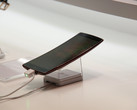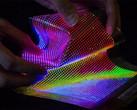We reported during CES 2018 that more notebooks with OLED panels would become very unlikely throughout the rest of the year and this continues to hold true now that Computex 2018 is coming to a close. Notebooks with IPS panels still dominate the market even after Asus' ludicrous dual-screen laptops and AI convertible experiments. Aside from the now-discontinued Lenovo ThinkPad X1 Yoga and Dell Alienware 13 R3, why are there still no notebooks with OLED?
We queried a couple of OEMs and their answers remain unchanged. In order to sell systems with OLED panels, there needs to be an available supply. Unfortunately, the number of OLED panel manufacturers are extremely small and these providers are apparently uninterested in mass producing large OLED panels for laptops at the moment. Samsung, for example, was responsible for the OLED panels on both the ThinkPad X1 Yoga and Alienware 13 R3, but its OLED resources are instead being poured into smartphones and large televisions. Laptop manufacturers like Lenovo and Dell are essentially at the mercy of the R&D schedules of Samsung and LG.
Currently, manufacturers appear content with investing more resources into IPS panels with faster refresh rates and response times. This year, for example, saw the introduction of 144 Hz and 3 ms IPS panels compared to the 120 Hz and 5 ms panels of yesteryear. 4K UHD panels with 144 Hz refresh rates still do not exist for notebooks and 17.3-inch notebooks with 144 Hz panels are extremely rare. It's possible that manufacturers will continue to iterate on IPS technology for laptops and we've certainly not heard of any talk otherwise. Exactly when we can expect OLED laptops to proliferate will be anyone's guess. For now, OLED and AMOLED continue to be nearly exclusive to smartphones and tablets.
Source(s)
Own


 Deutsch
Deutsch English
English Español
Español Français
Français Italiano
Italiano Nederlands
Nederlands Polski
Polski Português
Português Русский
Русский Türkçe
Türkçe Svenska
Svenska Chinese
Chinese Magyar
Magyar









